|
“IT’S A LITTLE TOO LATE TO DO THE RIGHT THING NOW” is a song sung by Tanya Tucker which pretty well sums the planting situation we now find ourselves facing with this prolonged drought. People have a tendency to try to react to a situation when it occurs rather than take action before the situation occurs again to lessen the impact of the bad situation. Most regions of the country experience extremes in the environment, i.e., floods one year followed by no rains or drought. Weather conditions never seem to be “perfect” or balanced with moisture and temperature. “Averages” seem to be calculated using extremes in moisture and temperature. For instance, if a person stands with one foot in boiling water and the other foot in ice water, on the “average”, that person should be comfortable. What we must identify are plant materials which can perform in these extremes, i.e., Bush Morning Glory or Moon flower (Ipomoea fistulosa) grows as well in a swamp as it does in a desert. Most of the plants identified as Texas SuperStar Plants at:
http://plantanswers.com/Articles/SuperStar_Plant_Listing.asp
and landscape plants recommended for south central Texas at: http://plantanswers.com/publications/southcnt.html
have the ability to endure environmental extremes if well- established (several years!) BEFORE the conditions become extreme.
“Drought-tolerant” plants should be referred to as “drought-survivable” plants. The plants do live through the experience but they are probably not as attractive or actively growing while the extremes are occuring. Drought-tolerant plants MUST BE planted well before the actual drought occurs so they can have an extensive and expansive rootsystem which can take advantage of every molecule of moisture which exists. The smaller a plants rootsystem, the less “adapted” to drought conditions. So it would be wise to wait until relief comes in the form of rains to moisten the subsoil before establishing adaptive drought-tolerant plants -- in preparation for the next drought period.
To make the situation even worse, woody plant material is also more difficult to establish during periods of prolonged drought. This is mainly due to depleted soil moisture which stimulates expansion and penetration of the young root system. When the soil profile is moist, roots can easily expand. When the soil profile is completely dry, roots are limited to the moisture added near the root ball which was established in the container in which it was grown. Because of this, the larger,woody transplants MUST BE watered directly at the base of the recently-established plants. Regardless of the wetness around the transplant’s rootball, if the rootball itself is not wet, the plant will die. Once dry, a plant’s rootball is almost impossible to wet while planted in the ground. To avoid this, soak the rootball of plants BEFORE planting them. Then supplemental water must be added slowly to allow complete soaking of the rootball and the recently-established plants must be watered at least weekly for the first six months and/or until at least one-inch of rainfall per week occurs. With no moisture in the soil and a concentrated root system, the transplant has to be handled as if were still growing in the plastic container in which it was purchased. In nurseries, the majority of plants in containers are watered daily and some more often during adverse weather conditions of extreme heat. In soil, as in containers, if the rootball dries, even once, the plant will be severely damaged, if not killed, i.e., if it dries – it dies.
One of the best ways to water a dried-and-hardened root system or root ball is to use the BECK BLASTER Water Drill. Following are instructions about making your own BECK BLASTER or where to order one.
BECK'S BLASTER WATER DRILL
August, 2011
Parts Needed:
1 hose shut off
1 female hose thread with swivel to 1/2 slip pvc
1 piece of 1/2 inch, schedule 40 pvc pipe (4 feet long)
1 piece of 1/2 inch, schedule 40 pvc pipe (1 foot long)
1 1/2 inch, 90 degree fitting (slip on both ends)
1 pvc 1/2 inch couple- female slip with male hose thread
1 fixed high pressure water nozzle (preferably brass)
1 pvc pipe primer and glue combo pack.
|
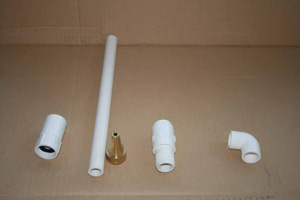
Parts for Beck's BLASTER Water Drill
|
The pvc pipe, glue, primer and brass high pressure nozzle can be purchased at your local hardware store.
The hose thread fittings are hard to find in some areas. If you can't find them locally, they can be ordered online from Mrdrip.com; sprinkler.com; jehmco.com; Hummert.com or other online sites.
The length of the drill can vary with the length of the half inch pvc pipe. Four feet long is a comfortable length, in most situations.
Use a one foot length of 1/2 pvc pipe as a handle.
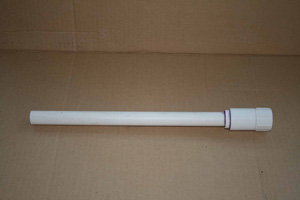
Step 1: Apply primer, then glue the female hose thread to 1/2 slip pvc piece to one end of the foot long pvc piece.
|
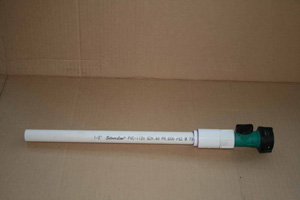
Step 2: Attach the hose shutoff to the female hose thread.
|
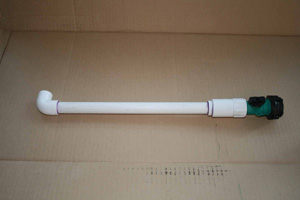
Step 3: Apply primer, then glue the 90 degree 1/2 inch fitting to the other end of the foot long pvc piece.
|
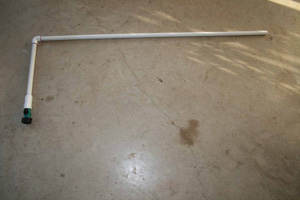
Step 4: Apply primer, then glue the 4 foot long piece to the other end of the 90 degree 1/2 inch fitting.
|
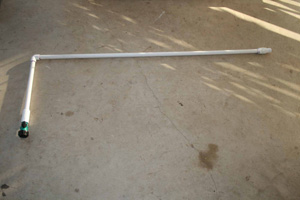
Step 5: Apply primer, then glue the pvc 1/2 inch slip couple female with male hose thread to the other end of the 4 foot long pvc piece.
|
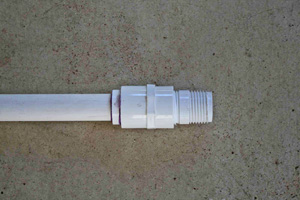
Step 5 Closeup
|
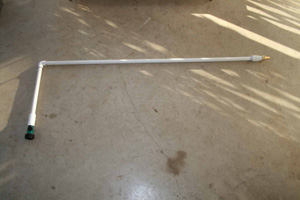
Step 6: Attach the high pressure nozzle to the male hose thread.
|
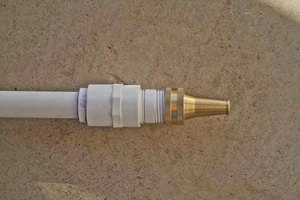
Step 6 Closeup
|
The water pressure allows the drill to make a hole until it hits rock.
If you need to tunnel under a sidewalk, dig a trench until you can lay the drill horizontally in the trench next to the sidewalk. Then use the drill to make your tunnel.
If you are in San Antonio and want to order one or some already assembled, contact Milberger's Nursery at: 210-497-3760 or send your order to: JerryParsons@PLANTanswers.com The assembled cost is $20. Kits can be mailed for $25 (Handling and Postage).
Below are images which shows how the Beck Blaster really works digging a hole in hard gravel:
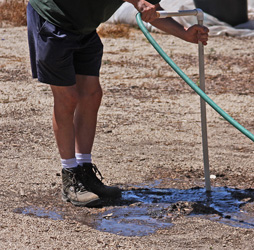
Beck Blaster is put in place where hole is desired.
|
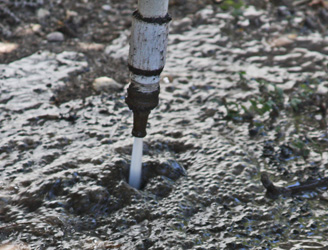
High Velosity flow of water digs into the lose rock and hard soil.
|
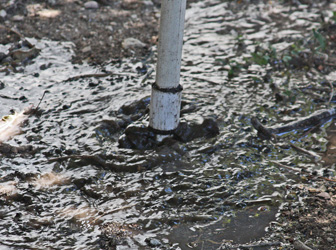
The water moistens the hard soil while the pressure flow pentrates as nozzle moves downward.
|
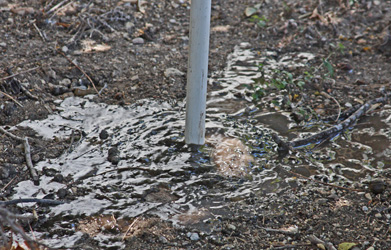
And the nozzle penetrates deeper.
|
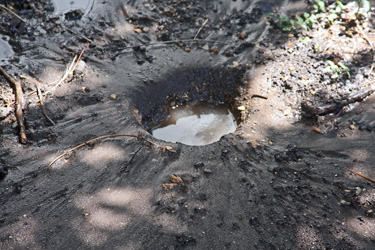
After the drilling the hole is 24 inches deep, the subsoil and the topsoil has been moistened and a hole remains for more waterings later.
|
|
 Watering Yard Trees In Severe Drought Tips Watering Yard Trees In Severe Drought Tips
The Beck’s BLASTER Water Drill looks like a good solution to watering and saving some of my mature trees.
QUESTION #1: Is there a general rule of thumb for the number of holes drilled based upon the size of tree?
ANSWER: Generally, the larger the tree or shrub, the larger the root zone and the surface area within the drip line (outer edge of the tree’s canopy or foliage). The majority of the “feeder” roots occur inward and outward from the drip line. Begin drilling holes** (approximately 24 inches deep or deeper if aeration and rewetting of subsoil is desired) at the drip line of the tree and space the holes 3 feet by 3 feet apart. When a large tree is involved, continue this 3’ x 3’ spacing under the tree for one-half the distance from the drip line to the trunk. Then use this same distance outward from the drip line to establish the outer boundary. If tree canopies overlap, consider the outer drip line of the combination of trees as one drip line.
QUESTION #2: Should the drilled holes be out at the drip line or slightly closer towards the trunk?
ANSWER: Holes should be drilled as mentioned above for older, well-established (for over 8 years) trees and shrubs. For trees and shrubs which have been established for less than 8 years, the 3’ x 3’ holes should be started directly into the original root ball and move outward within a 20 foot circle. The more recently planted trees and shrubs need drilling and soaking near the trunk and into the root ball since they have not had time to establish an enlarged root system.
QUESTION #3: If the drip line is compromised by hardscape, what is the minimum distance from the trunk to place the hole(s)?
ANSWER: This depends on the age of the planting. If the plants have been established for more than eight years, the feeder roots may be well beyond the hardscape so proceed as if the hardscape was not present. Drilling holes near the trunk will do little to stimulate the tree since few feeder roots exist near the trunk. For number of holes and spacing, follow instructions in Question #1. If the trees and shrubs have been planted for less than eight years, drill as close to the trunk as possible (avoiding roots) and into the establishing root ball.
QUESTION #4: Should the drilled holes be filled with anything?
ANSWER: Malcolm Beck says that he fills them with compost so that every time he waters in those holes, he is making beneficial compost tea. Or, you can just let them fill naturally.
** HINTS: Milton Glueck has observed an easier drilling procedure is to angle the hole rather than drilling straight down. This also waters and aerates more of the shallow feeder roots. Milton also found that the water drill penetrated faster if the tip was pulled backwards (towards the top of the hole) often to remove any accumulated, loosened diggings.
|



